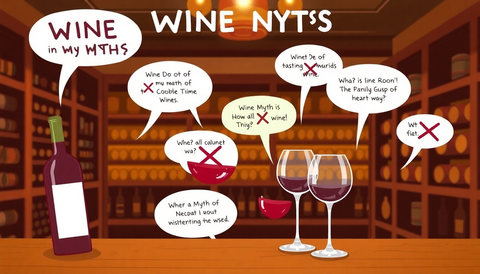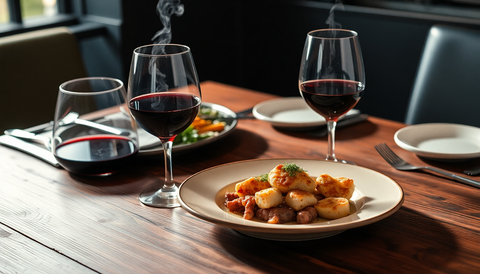As you swirl your glass of red wine, you may notice a certain drying sensation on your tongue and the insides of your cheeks. This is the work of tannins, a crucial component in the world of wine that often sparks curiosity and confusion among wine enthusiasts. In this comprehensive guide, we'll delve into the intriguing world of tannins, exploring their origins, their role in wine, and why they matter in the pursuit of a truly exceptional drinking experience.
Understanding Tannins
Tannins are a group of complex organic compounds found naturally in various plant-based foods and beverages, including tea, coffee, chocolate, and, most notably, wine. In the context of wine, tannins are primarily derived from the skins, seeds, and stems of grapes, as well as the oak barrels used during the aging process.
These astringent compounds interact with the proteins in our saliva, creating that distinctive drying sensation that many wine enthusiasts have come to appreciate. But tannins are much more than just a mouthfeel; they play a crucial role in the structure, flavor, and longevity of a wine.
The Science Behind Tannins
Tannins are polyphenolic compounds, meaning they are composed of multiple phenol groups. These phenol groups are responsible for the antioxidant properties of tannins, which can help protect the wine from oxidation and spoilage.
The specific chemical structure of tannins determines their astringency and bitterness. Larger tannin molecules, known as proanthocyanidins, tend to be more astringent, while smaller tannin molecules, such as catechins, are often perceived as more bitter.
The concentration and composition of tannins in a wine can vary greatly depending on factors such as the grape variety, growing conditions, winemaking techniques, and aging process.
The Role of Tannins in Wine
Tannins are not just a sensory experience; they serve several important functions in the world of wine.
Structure and Mouthfeel
Tannins contribute to the overall structure and body of a wine. They provide a sense of weight and texture, adding complexity and depth to the drinking experience. High-tannin wines, such as Cabernet Sauvignon and Nebbiolo, are often described as "full-bodied" or "robust," while lower-tannin wines, like Pinot Noir or Merlot, may be perceived as more "light" or "delicate."
Flavor and Aroma
Tannins can also influence the flavor and aroma profile of a wine. They can impart notes of bitterness, astringency, and even a subtle sweetness, depending on their concentration and the other components present in the wine. Tannins can also interact with other compounds, such as anthocyanins (responsible for a wine's color), to create unique and complex flavor profiles.
Aging and Longevity
One of the most significant roles of tannins is their ability to contribute to a wine's aging potential and longevity. As a wine ages, the tannins undergo a process of polymerization, where the individual tannin molecules bond together to form larger, more complex structures. This transformation softens the tannins, making the wine more approachable and integrated over time.
High-tannin wines, such as Cabernet Sauvignon and Barolo, are often considered "age-worthy," meaning they can develop and evolve for many years, sometimes decades, in the bottle. The gradual softening of tannins, combined with other chemical changes, allows these wines to develop nuanced and complex flavors as they mature.
Tannin Management in Winemaking
Winemakers play a crucial role in managing tannins throughout the winemaking process. Their decisions and techniques can significantly impact the final tannin profile of the wine.
Grape Selection and Maceration
The choice of grape variety and the winemaking techniques used during the maceration process (the period when the grape skins, seeds, and stems are in contact with the juice) can greatly influence the tannin content of the wine. For example, red grape varieties like Cabernet Sauvignon and Tannat naturally have higher tannin levels than varieties like Pinot Noir or Gamay.
Winemakers can also manipulate tannin extraction during maceration by adjusting factors such as temperature, time, and the use of enzymes or other additives. Longer maceration periods, higher temperatures, and more aggressive extraction methods can result in wines with higher tannin concentrations.
Oak Aging
The use of oak barrels during the aging process is another important factor in tannin management. Oak contains its own set of tannins, which can be imparted to the wine, contributing to its overall tannin profile. The type of oak (French, American, or Hungarian), the level of toast, and the duration of aging can all influence the tannin character of the final wine.
Fining and Filtration
Winemakers may also employ fining and filtration techniques to adjust the tannin levels in a wine. Fining agents, such as egg whites or bentonite clay, can bind to and remove excess tannins, while filtration can help remove larger tannin molecules, resulting in a smoother, more approachable wine.
Appreciating Tannins in Wine
As wine enthusiasts, understanding the role of tannins can greatly enhance our appreciation and enjoyment of wine. By recognizing the unique contributions of tannins, we can better navigate the world of wine and discover our personal preferences.
Tasting and Describing Tannins
When tasting a wine, pay attention to the sensation of tannins on your palate. Do you perceive them as drying, astringent, or even slightly bitter? How do they interact with the other flavors and aromas in the wine? Describing the tannin profile can be a valuable tool in understanding a wine's character and potential for aging.
Pairing Wines with Tannins
Tannins can also play a crucial role in food pairing. High-tannin wines, such as Cabernet Sauvignon or Barolo, often pair well with rich, fatty, or grilled meats, as the tannins can help cut through the richness of the dish. Conversely, lower-tannin wines, like Pinot Noir or Gamay, may be better suited for lighter fare, such as poultry or seafood.
Exploring the Aging Potential
For wine enthusiasts who enjoy the evolution of a wine over time, understanding tannins can be particularly rewarding. Cellaring high-tannin wines and observing their transformation as they age can be a fascinating and enlightening experience, revealing the complex interplay of tannins and other wine components.
Conclusion
Tannins are a fundamental component of wine, contributing to its structure, flavor, and longevity. By understanding the science behind tannins, their role in winemaking, and how to appreciate them in our drinking experiences, we can unlock a deeper understanding and enjoyment of the world of wine. Whether you're a seasoned oenophile or a curious wine lover, exploring the mysteries of tannins can open up a new dimension of appreciation for this captivating beverage.




Comments (0)
There are no comments for this article. Be the first one to leave a message!